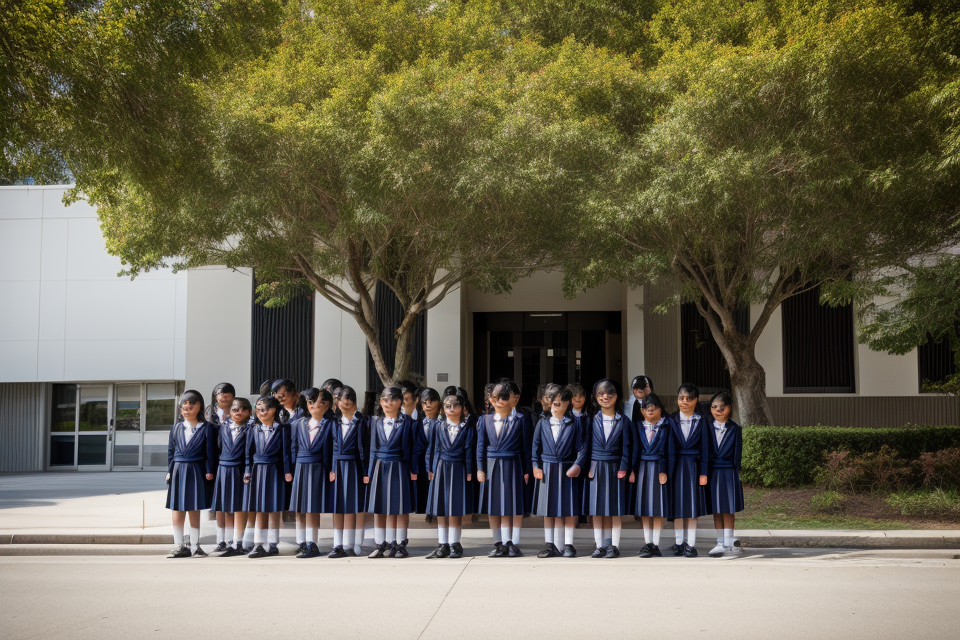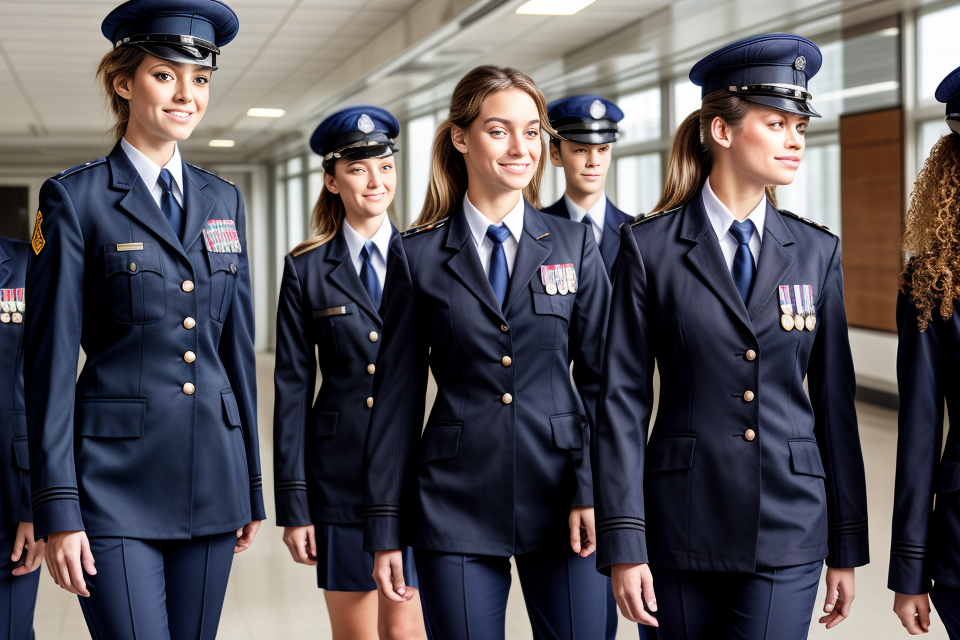
The topic of how uniforms affect students has been a subject of debate for quite some time now. On one hand, proponents argue that school uniforms promote a sense of unity and belonging among students, while on the other hand, critics claim that uniforms restrict students’ freedom of expression and individuality. However, beyond these arguments, there is a need to examine the impact of school uniforms on student safety and performance. In this article, we will explore the effects of school uniforms on students and how they can influence the way students feel, behave, and perform in school. So, let’s dive in to find out more!
School uniforms can have both positive and negative impacts on student safety and performance. On the one hand, school uniforms can increase safety by creating a more uniform and recognizable student body, making it easier for school staff to identify and monitor students. Additionally, school uniforms can help reduce the risk of bullying and gang-related activity by eliminating the display of logos or brands that may be associated with certain groups. On the other hand, school uniforms may not provide the same level of safety as required by schools. Additionally, some students may feel that school uniforms infringe on their individuality and freedom of expression. Overall, the impact of school uniforms on student safety and performance is complex and may vary depending on the specific policies and practices of the school.
The Effects of School Uniforms on Student Safety
Reduced Cases of Bullying and Violence
One of the primary reasons why schools implement a uniform policy is to reduce cases of bullying and violence among students. Research has shown that school uniforms can play a significant role in reducing these incidents.
Elimination of Distinctive Clothing
One of the most common reasons why students bully others is due to their appearance. When students wear distinctive clothing, they can become targets for bullies who perceive them as being different or inferior. By eliminating distinctive clothing, school uniforms help to reduce the likelihood of bullying based on appearance.
Promotion of Equality and Inclusion
School uniforms promote equality and inclusion by creating a sense of belonging among students. When all students wear the same uniform, they feel a sense of unity and belonging, which can help to reduce incidents of bullying and violence. Additionally, school uniforms can help to reduce social pressure on students to conform to certain fashion trends, which can also contribute to a more inclusive environment.
In conclusion, school uniforms can play a significant role in reducing cases of bullying and violence among students. By eliminating distinctive clothing and promoting equality and inclusion, school uniforms can help to create a safer and more inclusive environment for all students.
Enhanced Security Measures
Identification of Authorized Personnel
One of the ways in which school uniforms can impact student safety is by helping to identify authorized personnel. School uniforms can help to differentiate between students, teachers, and other staff members, making it easier for school officials to identify who should be on campus at any given time. This can be particularly useful in emergency situations, where it may be necessary to quickly account for all individuals in the building. By wearing school uniforms, students and staff can easily be identified and accounted for, which can help to improve overall safety and security.
Deterrence of Unauthorized Access
Another way in which school uniforms can impact student safety is by deterring unauthorized access to school grounds. When students and staff are required to wear school uniforms, it can be easier for school officials to identify individuals who do not belong on campus. This can help to prevent unauthorized access to school grounds, which can be particularly important in situations where there may be threats to student safety. By wearing school uniforms, students and staff can help to create a more secure environment, which can ultimately help to improve overall safety and security.
The Relationship between School Uniforms and Academic Performance
Improved Focus on Learning
One of the key benefits of school uniforms is the improvement in students’ focus on learning. By wearing a uniform, students are less likely to be distracted by concerns about what to wear, allowing them to focus more on their academic work. Additionally, the sense of responsibility that comes with wearing a uniform can also help students to take their academic work more seriously.
Reduction of Distractions
Research has shown that students who wear school uniforms have fewer distractions in the classroom, leading to better academic performance. Without the pressure of having to choose what to wear each day, students can concentrate on their studies and not worry about being judged by their peers based on their clothing choices. Additionally, uniforms help to create a sense of equality among students, reducing the likelihood of bullying and teasing based on clothing choices.
Fostering a Culture of Responsibility
Wearing a school uniform also helps to foster a culture of responsibility among students. By having a set of rules regarding what they can and cannot wear, students learn to take responsibility for their actions and understand the importance of following rules. This sense of responsibility can translate into better academic performance, as students are more likely to take their studies seriously and be motivated to succeed.
Additionally, school uniforms can help to create a sense of pride and belonging among students. When students feel a sense of connection to their school, they are more likely to take pride in their academic work and strive to achieve their best. Overall, the requirement to wear a school uniform can have a positive impact on students’ academic performance by reducing distractions, fostering a culture of responsibility, and creating a sense of pride and belonging.
Standardized Dress Code Promotes Equity
Minimizing Socioeconomic Disparities
School uniforms help minimize socioeconomic disparities among students by reducing the influence of fashion trends and brand names on student attire. By establishing a standardized dress code, all students wear similar clothing, regardless of their socioeconomic backgrounds. This uniformity eliminates the need for expensive brand-name clothing and accessories, leveling the playing field for all students.
Encouraging Modesty and Moderation
A standardized dress code also encourages modesty and moderation in student attire. School uniforms often include guidelines for appropriate length, style, and coverage of clothing, which can help prevent instances of immodest or revealing clothing. This can lead to a more focused and respectful learning environment, as students are less likely to be distracted by others’ clothing choices. Additionally, a standardized dress code can promote a sense of unity and belonging among students, as they all adhere to the same dress code, fostering a sense of community and shared values.
Positive Impact on Self-esteem and Body Image
Reduction of Pressure to Dress a Certain Way
One of the primary benefits of school uniforms is the reduction of pressure to dress a certain way. When students wear uniforms, they are not concerned about the latest fashion trends or brands. This takes away the pressure of trying to fit in with a particular group or conforming to societal norms. Instead, students can focus on their academics and building relationships with their peers based on common interests and values.
Increased Confidence and Self-assurance
School uniforms can also have a positive impact on self-esteem and body image. When students wear uniforms, they feel a sense of belonging and pride in their school. They are part of a community that values education and hard work. This can lead to increased confidence and self-assurance, which can translate into better academic performance. Students who feel good about themselves and their appearance are more likely to take risks and try new things, which can lead to personal growth and development.
Moreover, school uniforms can help to level the playing field for students who may feel self-conscious about their appearance. When everyone is wearing the same thing, it becomes less about fashion and more about academics. This can be particularly beneficial for students who may be teased or bullied for their clothing choices. By wearing a uniform, they can avoid the negative attention and focus on their studies.
In conclusion, school uniforms can have a positive impact on self-esteem and body image. They can reduce pressure to dress a certain way, increase confidence and self-assurance, and level the playing field for students who may feel self-conscious about their appearance. These benefits can translate into better academic performance and personal growth and development.
Addressing Concerns about School Uniforms
Affordability and Accessibility
One of the primary concerns regarding school uniforms is their affordability and accessibility. While some argue that school uniforms can be costly, others contend that they are essential in ensuring that students have a uniform to wear to school. In this section, we will discuss the availability of uniform allowances and partnerships with local retailers.
Availability of Uniform Allowances
In some schools, uniform allowances are provided to parents to help them purchase the required uniforms for their children. This allows families who may not have the financial means to purchase the uniforms to still provide their children with the necessary attire. In addition, some schools may offer used uniform sales or donations to further assist families in need.
Partnerships with Local Retailers
In an effort to make school uniforms more affordable and accessible, some schools have partnered with local retailers to offer discounts on uniform purchases. These partnerships can provide families with significant savings on the cost of uniforms, making it easier for them to purchase the required attire for their children. Furthermore, these partnerships can also help to support local businesses, which can have a positive impact on the community.
In conclusion, while concerns about affordability and accessibility are valid, there are options available to help families in need. Schools can provide uniform allowances, offer used uniform sales or donations, and partner with local retailers to make uniforms more affordable and accessible. These measures can help to ensure that all students have the necessary attire to attend school, regardless of their financial situation.
Limitations on Personal Expression
Striking a Balance between Individuality and Unity
One of the primary concerns surrounding school uniforms is the limitations they place on personal expression. Students often view their clothing as a means of self-expression and a way to showcase their individuality. While uniforms can promote a sense of unity and equality among students, they may also stifle creativity and personal style.
Exploring Alternatives to Mandatory Uniforms
To address concerns about personal expression, some schools have implemented optional uniform policies or dress codes that allow for more personal expression while still maintaining a level of appropriateness and modesty. These policies may include guidelines for acceptable clothing items, colors, and styles, but allow students to express their individuality within these boundaries.
Other schools have embraced a more flexible approach to dress codes, allowing students to express themselves through their clothing choices within certain limits. This approach acknowledges the importance of personal expression while still maintaining a focus on the educational environment and student safety.
Overall, striking a balance between individuality and unity is crucial when considering the impact of school uniforms on student safety and performance. While uniforms can promote a sense of community and unity, it is important to also acknowledge the importance of personal expression and individuality in fostering a positive learning environment.
The Verdict on School Uniforms
The impact of school uniforms on student safety and performance has been a topic of much debate. While some argue that school uniforms can improve safety and discipline, others contend that they restrict personal expression and infringe on students’ rights. However, recent research suggests that the benefits of school uniforms may outweigh the drawbacks.
Balancing Safety, Performance, and Personal Expression
One of the main advantages of school uniforms is that they can help improve student safety. Uniforms can make it easier for school administrators to identify unauthorized individuals on campus and reduce the likelihood of bullying and harassment based on clothing choices. Additionally, school uniforms can promote a sense of belonging and unity among students, fostering a more positive school environment.
On the other hand, some argue that school uniforms restrict personal expression and infringe on students’ rights to individuality. However, it is important to note that school uniforms do not completely eliminate personal expression. Students can still express themselves through accessories, hairstyles, and other non-uniform items. Moreover, many schools offer a variety of uniform options, allowing students to choose from different styles and colors.
Future Directions for Research and Policy
Despite the benefits of school uniforms, there is still much to be learned about their impact on student safety and performance. Future research should explore the long-term effects of school uniforms on students’ self-esteem, academic achievement, and social behavior. Additionally, policymakers should consider the costs of implementing and enforcing school uniform policies, as well as the potential impact on low-income families who may struggle to afford the required uniforms.
In conclusion, the verdict on school uniforms is mixed. While they can improve student safety and promote a positive school environment, they may also restrict personal expression and infringe on students’ rights. However, with careful consideration of the benefits and drawbacks, school uniforms can be a valuable tool for promoting a safe and supportive learning environment.
FAQs
1. How do school uniforms impact student safety?
School uniforms can have a positive impact on student safety by creating a sense of belonging and promoting a sense of community within the school. When students wear uniforms, they are easily identifiable as being part of the school community, which can help to reduce incidents of bullying and violence. Additionally, school uniforms can help to reduce the likelihood of gang-related activity, as students are less likely to wear clothing associated with gangs or other groups.
2. Can school uniforms improve student performance?
There is mixed research on whether or not school uniforms can improve student performance. Some studies suggest that school uniforms can help to improve student behavior and reduce disciplinary issues, which can in turn lead to improved academic performance. However, other studies have found that there is no significant relationship between school uniforms and academic performance. It is important to note that other factors, such as the quality of education and support systems in place, can have a much greater impact on student performance.
3. What are the potential drawbacks of requiring students to wear uniforms?
One potential drawback of requiring students to wear uniforms is that it can limit their ability to express their individuality. Some students may feel that their personal style is stifled by having to wear a uniform, which can lead to feelings of frustration and resentment. Additionally, school uniforms can be expensive, which can create a financial burden for families who are already struggling to make ends meet. Finally, school uniforms may not be appropriate for all types of weather, which can create discomfort for students during certain times of the year.
4. Are there any cultural or religious objections to requiring students to wear uniforms?
Yes, there can be cultural or religious objections to requiring students to wear uniforms. Some students or families may have cultural or religious beliefs that are in conflict with the school’s uniform policy, which can create tension and conflict. For example, some religious beliefs may require students to wear certain types of clothing or accessories that are not allowed under the school’s uniform policy. It is important for schools to be sensitive to these objections and to work with families to find solutions that respect their beliefs while still adhering to the school’s policies.

